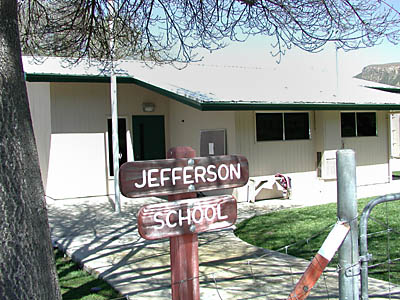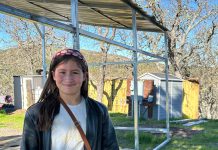
One-room schools set in rural areas seem like a part of
”
Little House on the Prairie,
”
but they are very alive and active all over the nation.
There are five such schools in San Benito County.
Thirty-five miles south of Hollister is Jefferson School, a
small, one-room school with 12 students, a teacher, a teacher’s
assistant
– and a dog.
One-room schools set in rural areas seem like a part of “Little House on the Prairie,” but they are very alive and active all over the nation.
There are five such schools in San Benito County.
Thirty-five miles south of Hollister is Jefferson School, a small, one-room school with 12 students, a teacher, a teacher’s assistant – and a dog. Other than Bitterwater-Tully School at the county’s southwestern point, Jefferson is the farthest school from Hollister serving families who live in the county’s rural area.
“These schools deserve to exist,” said Kathy Green, who’s both principal and a teacher at Jefferson. “We’re too far from civilization to ship these kids out.”
The Paicines campus houses a classroom, a multi-purpose room, a playground and a field for running or playing ball.
Jefferson’s 12 students are an enrollment peak; the school has had as few as six students. Grades kindergarten through 8 are served in one classroom.
Green has divided the classroom into two sides – the “little” and “big” kids have their desks on different sides of the classroom. There are five “little” kids in grades K through 2 and seven “big” kids in grades 3, 6 and 8.
Having such a wide range of ages can present problems for a teacher.
“I need them to be individual learners and ask questions if they need to,” Green said. “These are skills they’re going to need anyway. We just promote them (skills) very early here.”
Eighth-grader Amanda Rangel has been at Jefferson for all nine years of her academic life. She said it can be hard to be in the same room with kids of so many different ages.
“Some of them are really noisy,” she said, adding that the hubbub can distract other students.
Students do assigned work out of textbooks and workbooks. They ask questions when they need to and work with students in the same grade.
There are two eighth-graders, two sixth-graders, three third-graders, two second-graders, one first-grader and two kindergartners. The students come from seven families.
Green, in her sixth year at Jefferson, came from Hawaii and had many job options, but decided on a rural school.
“I chose this school above others. I thought it was an opportunity to be part of history,” she said. “This is so unusual. It’s really special to be a part of.”
The average day
All students in first grade and up have duties that include taking care of the flag, unlocking doors and picking up playground toys, Green said.
The typical school day starts at 8:30 a.m. by saluting the flag outside the school. “Big” kids run laps outside and “little” kids go over the date and sing songs to reinforce concepts and ideas.
By 8:50 a.m., all students are in the classroom and working on their math assignments for the day. On Tuesday, younger students rolled dice and added the numbers while eighth-graders worked on algebra problems.
Green said all eighth-graders are taught algebra to help ease the transition from small school to high school.
“It’s a rough adjustment socially. We try hard to prepare them academically,” she said. “When eighth-graders are taught algebra here, they’re more confident when they take it at high school.”
When finished with their textbook or workbook assignments, students ask to use a math choice. This allows them to use toys or computer programs to reinforce the math they’re studying, Green said. There are six computers available.
“When they’re done with their work, they can choose something to do to enhance their work,” she said.
At 10 a.m. the students go out for recess. They can play in the playground area that houses bars and swings or they can play “tag” on the grass area in front of the classroom. At 10:15 a.m., they’re called back into class to begin their language arts lesson. Again, students work from books and then can ask for a language choice to work on the computer or read.
Computer programs test students through crossword puzzles and construction of letters of the alphabet. The younger students are taken aside for oral work on letters and vowels. At 11:40 a.m., students read until lunch. On Tuesday, younger students read from big books while other students read to each other or by themselves.
Lunch is from noon to 12:45 p.m. Most students eat outside when the weather is warm, as it has been lately.
From 12:15 p.m. to the end of the school day at 3 p.m., students study social science or science. They also study electives, including piano, physical education, art and, twice a week, computers.
“We work on computers twice a week because that’s something they’re going to need a lot in the future,” Green said.
Hardships
Jefferson School is located just off the San Benito Lateral, seven miles south of Pinnacles National Monument. The family farthest away from the school lives seven miles north on Highway 25, Green said.
Because of the rural nature of San Benito County, schools such as Jefferson serve a need – families don’t have to drive an hour to take their children to school. Most parents are farmers or ranchers and can’t afford to break up their morning and afternoon work to drive an hour round-trip to city schools, Green said. But once they’re in ninth grade, students need to move on; most of them go to San Benito High School.
“It’s difficult and stressful for families,” Green said. “The answer is not to have another high school (around here) – the answer is to have help (with transportation).”
Green said she wishes the San Benito High School District would bus students to and from school to assist parents.
“When these students turn 16, they get their license and they get a car,” she said. “I worry about 16-year-olds getting cars and driving that road (Highway 25).”
While transportation is a hardship, moving from a school of 10 or 12 students to one of 2,500 can be a shock. That’s why Green tries to make sure students are prepared academically so they can cope with the social changes without having to cope with academic hardships at the same time.
“By that time, they’re ready to go and be with more children their age,” she said.
Green tries to have a former Jefferson School student show eighth-graders around campus to ease the adjustment. Eighth-grader Rangel has visited SBHS a few times this year and registered for classes Monday. Although she realizes how big the high school is, Rangel said she doesn’t feel nervous. She said she’s good at adjusting and feels she was prepared for high school at the one-room school.
“I think I’m in good shape. All the teachers I had were great,” Rangel said.
Accountability
Because Jefferson School District is small and has no superintendent besides Green, accountability is mostly in the hands of parents.
Green is observed by San Benito County Office of Education personnel three times a year, she said. No one tells her to align her curriculum with the state’s content standards, but Green does so because, she said, she is self-motivated.
Students take the state’s STAR test, but because the groups tested are so small, test results are reported only to Green and parents to protect student confidentiality. The County Office of Education doesn’t even receive the scores, Green said.
Because the school is so small, parents are very active and involved. If they had concerns about students’ academic or physical health, Green and the community would know about them, she said. Also, if students weren’t doing well at SBHS, that would be a red flag.
Green also handles the district’s budget of about $100,000.
“It could be very dangerous to have someone come in who doesn’t have the motivation (to do well and challenge students),” she said.









